Gone are the days when office-bound routines define our workdays. In this new era, a significant number of professionals find themselves embracing the flexibility of working from home, while others still navigate the familiar corridors of office buildings.
This blend of work styles has become a new normal post-pandemic, but it’s important to weigh the pros and cons of working from home compared to the traditional office environment.
In this post, we’ll compare the working arrangements side-by-side to help you understand the advantages and disadvantages of each.
Working from Home Stats
The question on the minds of employers is: Does WFH translate into better work, healthier employees, and more effective brainstorming? And what does the future of in-office work hold?
A survey by McKinsey uncovered that 35% of professionals have the option to work from home full-time since the pandemic.
Some more interesting WFH statistics:
- 52% of people work remotely at least once a week
- Companies that offer remote work have 25% lower employee turnover rate
- 51% of employees prefer remote work because it improves work-life balance
- 76% prefer to avoid office when they need to concentrate on an important task
- 77% of remote employees are more productive when they work from home
- 25% of employees would take up to 10 percent pay cut to work remotely
- 10% of employees work remotely full time
And although many employees feared the return to the office after the pandemic, remote work is only expected to grow:
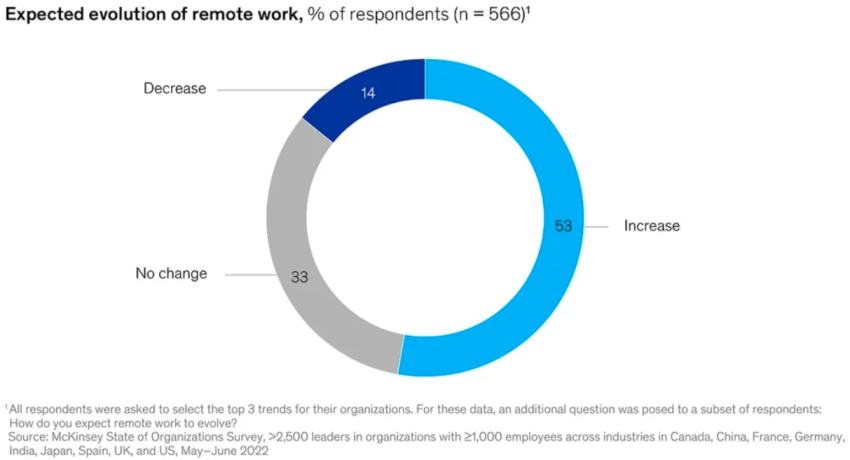
Comparison: Working from Home vs Office
Keep in mind that some of these pros and cons may seem to contradict each other.
For example, productivity can be better in an office because of the structure and support, but it can also be worse in an office because of distractions. Neither the office nor the home office is perfect, so take this table as a general informational guideline and decide which is best for you overall.
| Pros of Working From Home | Cons of Working From Home | Pros of Working in an Office | Cons of Working in an Office |
|---|---|---|---|
| Flexible Schedule | Isolation and Lack of Social Interaction | Structured Work Environment | Commuting Stress and Time Consumption |
| Customizable Workspace | Distractions and Home Responsibilities | Opportunities for Collaboration and Networking | Less Personal Freedom and Flexibility |
| Less Commuting and Work-related Expenses | Communication Challenges | Access to Resources and Immediate Support | Office Politics and Distractions |
| Increased Productivity and Performance | Technology and Costs | Clearer Work-Life Boundaries | Limited Control Over Work Environment |
| Better Work-Life Balance | Difficulty with Work-Life Balance | Enhanced Learning and Professional Growth | Potential Health Impacts |
Pros of Working From Home
1. Flexible schedule
When working from an office, you have a set schedule. Your alarm goes off at the same time every day, you grab your morning coffee to go, and you’re at your desk by 9 a.m., ready to work. But when it comes to working from home, it’s a little different. You have the flexibility to wake up when you choose and tailor your day to your needs.
Remote workers often have the liberty of setting their schedules, allowing them to work during their most productive hours, whether that’s early morning or late at night. You can wake up later, pick your own time for lunch, and close your laptop when you want — for some, that’s 4 p.m., for others, it could be 7 p.m.
People love this flexibility because it’s much easier to tend to personal responsibilities, such as childcare or attending appointments, without the need to request time off.
Some companies, of course, still want their remote employees working the in-office work hours of 9-5. But that doesn’t mean you can’t take a refreshing catnap in the middle of the day!
For employers, attracting and retaining top talent is of strategic importance, and study respondents rated flexible working arrangements as one of the top reasons to seek a new job:
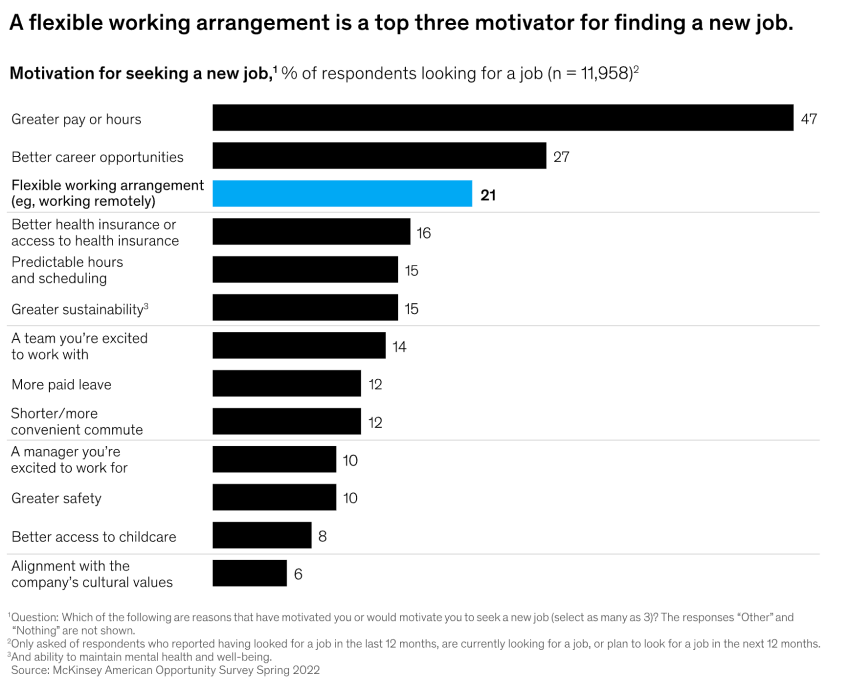
2. Customizable workspace
Working from home allows you to create your ideal work environment.
Whether it’s a quiet corner in a bedroom or a dedicated home office, whether it’s cozy or minimalistic, remote workers can design a space that maximizes their comfort and productivity. You can choose a standing desk over a sitting one and select your choice of office furniture (enjoy that balance ball chair without everyone who passes you commenting on it!).
The absence of a dress code further enhances this comfort, enabling employees to work in attire that makes them feel most at ease. Pajamas, anyone? One survey revealed that 30% of respondents wore pajamas while on virtual meetings. Just make sure not to stand up during a Zoom call if you’re not wearing pants, as this man did!
3. Savings on commuting and work-related expenses
The average American worker spends around 30 minutes on their daily commute to work:
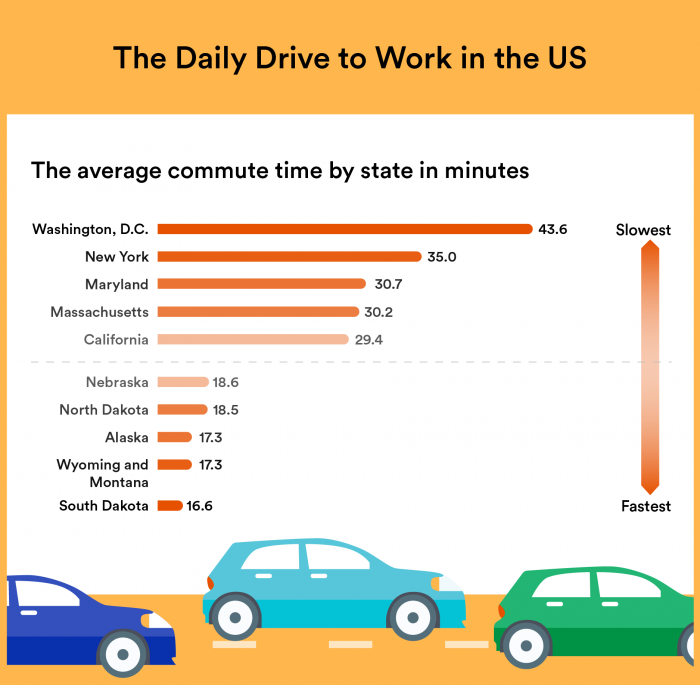
A work-from-home job can save employees a lot on the usual automotive expenses, like insurance, maintenance, and fuel. Or if you use public transportation, a remote job can save on fares, waiting time, and missed buses.
The time you waste on commuting could be put towards other things, like spending more time with family, exercising, hobbies, or even starting a small business on the side. It’s far more lucrative than sitting through traffic jams!
Additionally, there are savings on work-related expenses like professional attire, lunches out, and daily coffee runs. These cost reductions can have a substantial impact on an individual’s budget.
4. Increased productivity and performance
Many remote workers report higher productivity levels when working from home. The absence of office distractions, less time spent in meetings, a lack of constant chit-chat in the halls, and the comfort of a personalized workspace can lead to more efficient workdays.
Needless to say, productivity can get a huge uptick with remote workers. For example:
- Employees who work from home boost their productivity by 13%
- 55% of employees say they log in more hours while working remotely than at the office
- 64% of people believe that asynchronous communication drives their most productive hours
Asynchronous communication, the “new productivity powerhouse,” is a method of exchanging information without the expectation of real-time feedback:

5. Better work-life balance
Working from home can significantly improve work-life balance. In a study by PwC, 67% of employees say they achieve a better balance of their personal and professional lives when working from home.
The elimination of commute time gives employees more hours in their day, which can be used for personal activities, relaxation, or spending time with family. This balance often leads to reduced stress levels and higher overall job satisfaction.

Cons of Working From Home
1. Isolation and lack of social interaction
One significant drawback of working from home is the potential for feeling isolated, particularly for those who are extroverts. For introverts, this may actually be a pro, not a con. But for anyone, the absence of daily interactions with colleagues can lead to a sense of loneliness and detachment from the company culture.
This lack of social engagement can be challenging for those who are used to these kinds of interpersonal connections. The absence of informal conversations and the camaraderie found in physical office environments may result in decreased job satisfaction and a sense of disconnection from team dynamics.
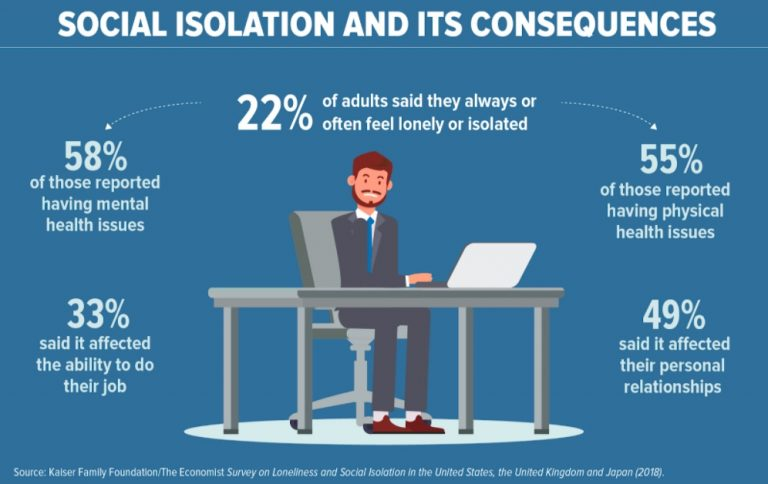
Prolonged isolated working from home has been associated with a range of health issues. This sedentary lifestyle can lead to serious medical conditions, such as slower digestion and physiological changes. Many individuals have witnessed a decline in muscle strength, energy levels, and overall health.
It also takes a toll on our mental health. Reports suggest a sharp increase in depression cases, as well as other psychological problems. Anxiety attacks and elevated blood pressure have become common symptoms of this isolated and sedentary lifestyle, significantly deviating from a healthy and balanced lifestyle.
Regular virtual social events or check-ins with one’s manager, or even in-person happy hours (if possible), can help maintain a healthy and inclusive workplace culture, even from a distance.
Related: 13 Tips for Building an Amazing Remote Work Culture
2. Distractions and home responsibilities
Working from home requires a high level of self-motivation and discipline. The lack of direct supervision and the informal nature of the home setting can lead to procrastination and decreased productivity for some individuals who may require a more structured environment.
Plus, the home environment, while comfortable, often comes with numerous distractions. From household chores to family members, it can be challenging to maintain focus. When faced with a complex work task, those dishes piled up in the sink suddenly seem like the fun task! Additionally, the blurred lines between personal and professional life may lead to increased stress, as work can encroach on family time and vice versa.
3. Communication challenges
Communication with team members can become more challenging, potentially leading to misunderstandings or delays in project completions.
In our State of Business Communication Report, face-to-face communication is the most preferred communication method in the work environment. Being physically present in the office allows for spontaneous interactions, water cooler conversations, and the opportunity to converse in person.
Employees also miss the stimulating conversations across departments that naturally occur in an office environment. These conversations lead to the exchange of ideas, cross-functional learning, and a deeper understanding of the organization as a whole.
Studies show that Zoom exhaustion is felt by remote workers and can have an impact on one’s mental and physical health. That’s why choosing the right form of business communication is beneficial in a WFH situation. You don’t even need a laptop. With a full-featured business phone app, employees can make and receive calls, attend conference calls, message colleagues, and stay online using their iPhone or Android.

Ultimately, the value of face-to-face interaction cannot be replicated by technology solutions. The non-verbal cues, body language, and spontaneous exchanges all contribute to more effective communication and stronger relationships.
Switch to Nextiva today and save up to 60%
Join now and start calling in less than 10 minutes. Instant set up. Enterprise-grade reliability.
4. Technology and costs
Remote work heavily depends on technology, which can sometimes be unreliable. Issues like internet connectivity problems or technical glitches can disrupt work. And when it’s just you at home, you don’t have the benefit of having the in-house IT person pop over to your desk to fix it.
Plus, although you may save on commuting costs, working from home has other costs. You’re responsible for your own internet costs, prolonged electricity costs, and sometimes costs for telecommuting technology. Typical work-at-home expenses also include desks, chairs, computers, network routers, scanners, etc. While you save in some ways, there are other types of costs to think about.
5. Difficulty with work-life balance
Remote work can sometimes lead to a poor work-life balance as the boundaries between ‘work time’ and ‘personal time’ become less distinct. This can result in working longer hours, difficulty in switching off after work, and a feeling of being constantly connected to work responsibilities.
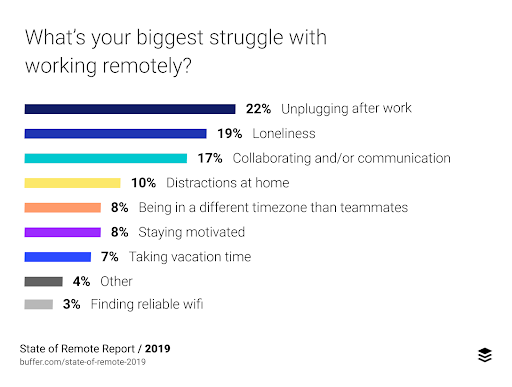
Pros of Working in an Office
1. Structured work environment
One of the primary advantages of office work is the structured environment it provides. Regular work hours and a physical office space signals the brain that it’s time for professional tasks, helping to reduce distractions that might be present in a home environment. There’s no sneaking off to watch an episode of The Crown when you’re in an office!
The office setting generally provides a more consistent routine, with set hours for work and breaks, particularly if you have to stagger breaks with another employee.
Working in an office environment can help with time management in a few ways:
- By adhering to strict schedules and deadlines, office employees learn the art of efficiently perceiving and using their time.
- Taking concise yet necessary lunch breaks allows individuals to recharge while ensuring minimal disruption to their workflow.
- The office routine establishes a structure that aids in streamlining task completion and enhancing overall efficiency.
2. Opportunities for collaboration and networking
Working in an office setting fosters collaboration and networking in many ways:
- Face-to-face interactions with colleagues can spur creativity, quick problem-solving, informal networking, and the development of professional relationships. This environment is particularly beneficial for team-based projects and brainstorming sessions.
- The physical presence of colleagues in an office setting makes it easier to engage in spontaneous conversations and brainstorming sessions. These interactions are not only quicker but often more effective compared to virtual communication, as they allow for immediate feedback, non-verbal cues, and a more personal connection.
- Offices often host a variety of professional events, meetings, and casual get-togethers, providing ample opportunities for networking. Plus, employees are more likely to interact with members of different departments. These cross-departmental interactions can spark innovative ideas and collaborative projects that might not have been conceived in a remote setting.
And just being in an office immersed in the company’s culture can create a shared sense of purpose and belonging. This shared culture can foster collaboration, as employees feel more aligned with the company’s goals and values.
3. Access to resources and immediate support
Offices are typically equipped with essential resources and support systems that may not be available at home. This includes access to high-speed internet, office furniture and equipment, technical support, and some food and beverages. Not only that, but immediate access to supervisors or mentors for guidance can be invaluable.
Many managers are concerned because they’ve never had to manage a remote workforce. When working from an office, managers have a clear view of what team members are working on. They can go up and ask questions, have daily check-ins, and have whiteboarding meetings to make sure everything is on track.
That’s not the case when it comes to working remotely. Which is why having the right tools is critical for remote work success. We leverage a combination of great leadership and powerful communication tools to knock out big projects.

As a manager, you might have the desire to micromanage employees as they go remote. Instead, we suggest trusting people to perform until they prove otherwise. Employees want to do well; it’s your job to help them get there.
4. Clearer work-life boundaries
Despite the popularity of remote work, many employees struggle to disconnect when working from home. Up to a third of employees say they struggle to achieve work-life balance when working remotely.
The most significant factor is the physical separation between the workplace and home. Offices typically operate on a fixed schedule with designated start and end times. It’s easy to shut down your computer when you see fellow office workers start to pack up for the night, whereas when you’re at home, those workspace cues don’t exist.
There are significant social cues from the environment which signals to your brain that are in work mode. The office, with its professional setting and the presence of colleagues, serves as a constant reminder of the work context. These social cues help in maintaining a professional mindset, so the chances of personal life intruding into work time are minimized.
Plus, the act of commuting to and from the office serves as a transitional period, allowing employees to prepare for the workday ahead and then wind down afterwards.
5. Enhanced learning and professional growth
Being in an office environment can offer enhanced learning opportunities and professional growth. Regular interactions with experienced colleagues and exposure to different aspects of the business can provide valuable insights and learning experiences that are harder to replicate remotely.
For example, being in a physical office allows employees to learn by observing their peers and superiors. This can include everything from technical skills to professional behavior and workplace etiquette. Observing how others handle challenges, communicate, and manage their work can provide practical, real-world learning that is difficult to replicate remotely.
Feedback can be given immediately and directly, whether it’s during a meeting, a spontaneous conversation, or a formal review session. This immediacy accelerates learning and improvement, as employees can quickly understand and apply the feedback.
It’s also usually easier for employees to work together on projects and tasks, which allows individuals to share knowledge, brainstorm ideas, and learn from each other’s strengths and experiences. And staff members might have the opportunity to engage in a broader variety of tasks and roles, either formally or informally. This exposure can be a rich learning experience, contributing to a more well-rounded skill set.
Cons of Working in an Office
1. Commuting stress and time consumption
One significant downside of office work is the dreaded daily commute. Traveling to and from work can be time-consuming and stressful, particularly in areas with heavy traffic or limited public transportation options. A lot of people live outside of the city center where housing is less expensive, so commute times can easily be up to an hour in each direction.
This not only eats into personal time, but can also lead to increased stress and fatigue.
2. Less personal freedom and flexibility
Working in an office often means adhering to a strict schedule and dress code, which can limit personal freedom and flexibility. Some people simply aren’t cut out for being productive in the first couple of hours of the morning, but at a 9-5 job, you don’t usually have a choice. And others can’t stand wearing ties or formal business outfits. It’s much more comfortable working in a t-shirt and sweatpants!
Employees may also find it challenging to attend to personal matters such as doctor’s appointments or balance family responsibilities like a sick child with a rigid 9-5 work schedule.
In an office environment, there’s usually less autonomy in how tasks are approached and completed. Employees are expected to conform to the established norms and practices of the workplace, which can limit creativity and the ability to work in a way that best suits their individual style.
This lack of flexibility can be particularly challenging for those who thrive under more self-directed conditions.
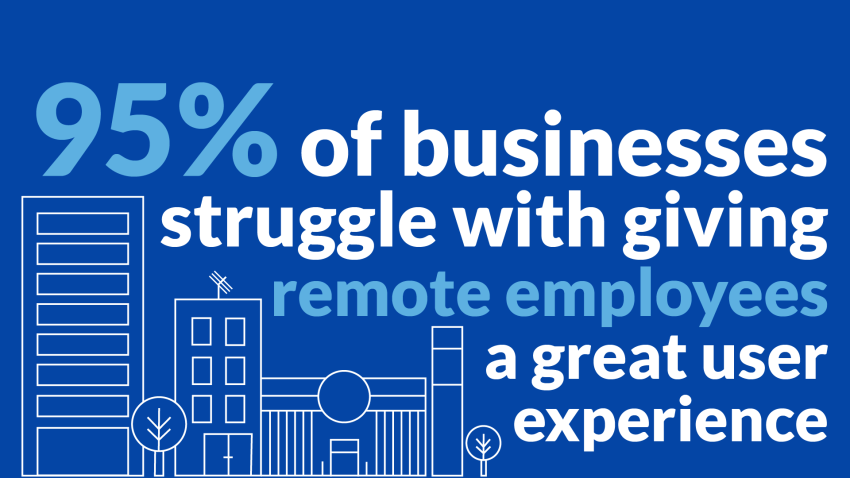
3. Office politics and distractions
Office environments can sometimes be breeding grounds for politics and interpersonal conflicts. Have you ever sat in your cubicle trying to work while the people on either side of you bicker? Navigating complex relationships and office dynamics can be stressful and may detract from an employee’s focus and job satisfaction.
And if you work in an office with an open-floor plan, which was designed to foster collaboration, it can often lead to more interruptions. These frequent interruptions can disrupt the flow of work and reduce efficiency.
In fact, a study conducted by UC Irvine found that a typical office worker is interrupted every 11 minutes. If that wasn’t bad enough, it takes 25 minutes to get back on task. Yikes. That’s a big hit to employee productivity.
4. Limited control over work environment
In an office, you don’t have a choice about the physical work environment, such as the open-floor plan. One office space generally does not suit everyone’s preferences. Employees often cannot choose their desk location, and being assigned the desk next to the kitchenette or bathrooms can be very distracting.
For some, the open floor is an ideal way to work. But for others, the myriad of simultaneous conversations, a noisy coworker and hum of the air conditioner can be off-putting.
The constant visual stimulation, such as people walking around, bright lights, or even the decor can be overwhelming for some individuals. This can lead to sensory overload, affecting mental well-being and productivity.
And even the temperature can have two employees vying over the thermostat all day long. Try typing out your report when the AC is on high and your fingers are icy!
5. Potential health impacts
Working in an office, especially in a sedentary position, can have health implications, such as strain from prolonged sitting or exposure to poor air quality. Additionally, shared spaces can increase the risk of illness, particularly during flu season or health outbreaks.
Conclusion: Finding the Right Balance
The decision between working from home and working in an office depends on a multitude of factors, each carrying its own set of pros and cons. The key lies in finding a balance that best suits individual needs and preferences, as well as the requirements of the job.
For some, the flexibility and comfort of working from home may outweigh the isolation and potential distractions. For others, the structured environment and collaborative nature of office work might be more conducive to productivity and professional growth. In many cases, a hybrid approach, combining elements of both, could be the optimal solution.
The team at Nextiva works remotely, and we’ve realized even more notable productivity gains from our cloud phone system to accelerate the shift from the office to working from home. Nextiva can help your company boost productivity with a single communications solution.
Related: Hybrid Work Model or RTO? Which Is Right for Your Business?
Switch to Nextiva today and save up to 60%
Join now and start calling in less than 10 minutes. Instant set up. Enterprise-grade reliability.
Working from Home FAQs
These benefits can vary depending on individual circumstances and the nature of the work, but here are some of the most commonly cited advantages of remote work life:
Flexibility: One of the biggest advantages is the flexibility in scheduling. Employees can often set their own hours, allowing them to work when they are most productive and balance personal responsibilities, like childcare or appointments.
No Commute: Eliminating the daily commute saves time and money, and reduces the stress associated with traffic or public transportation. This can also have a positive environmental impact due to reduced carbon emissions.
Improved Work-Life Balance: Working from home can make it easier to balance professional and personal life. This can lead to greater overall satisfaction and reduced stress levels.
Increased Productivity: Many people find they are more productive when working from home, due to fewer office distractions, less office politics, and a personalized, comfortable work environment.
Cost Savings: Working from home can lead to significant savings on commuting costs, work attire, and often on food, as home-cooked meals are generally less expensive than eating out or buying lunch.
Customizable Work Environment: Employees can set up their workspace as they prefer, which can lead to increased comfort and efficiency.
Reduced Office Expenses: For employers, remote work can mean reduced costs in terms of office space, utilities, and other overheads.
Access to a Wider Talent Pool: Employers can hire the best talent regardless of geographic location, leading to more diverse and skilled teams.
Less Exposure to Illness: Especially relevant in the wake of the pandemic, working from home can mean less exposure to contagious illnesses, which is beneficial for both employee health and overall public health.
Better for the Environment: Remote work can reduce the environmental impact by decreasing the number of commuters, thus lowering emissions and reducing a company’s carbon footprint.
Greater Autonomy: Working from home often gives employees more control over their work, which can lead to increased job satisfaction and a sense of empowerment.
Opportunity for Healthier Habits: The flexibility can allow for more time to exercise, prepare healthier meals, and follow a more balanced daily routine.
Here are some valuable tips to maintain productivity if you work remotely:
Create a structured routine: Establish a clear plan for each day and stick to it. This will help you stay focused and complete your tasks efficiently.
Maintain a sense of separateness: Designate a designated workspace in your home and treat it as your dedicated office area. This will help create a mental separation between your personal and professional life, enhancing your productivity.
Minimize distractions: Identify potential distractions in your home environment and take steps to minimize them. This could include setting boundaries with family members or implementing strategies to limit interruptions.
Leverage technology: Use tools and software that enhance remote collaboration and communication. These tools can help you stay connected with your team and streamline workflows.
Take regular breaks: Remember to give yourself short breaks throughout the day to recharge and avoid burnout. This will help maintain your focus and productivity levels.
Prolonged isolated remote work has been associated with a range of negative effects, including decreased physical activity and various mental health issues.
Due to the absence of regular physical movement involved in commuting to an office, many individuals have witnessed a decline in muscle strength, energy levels and overall health. This sedentary lifestyle can also lead to serious medical conditions, such as slower digestion and physiological changes.
There can also be an increase in depression, anxiety attacks and elevated blood pressure from an isolated and sedentary lifestyle, significantly deviating from a healthy and balanced lifestyle.
Remote working from home can be more stressful because:
Blurred Work-Life Boundaries: Not having an in-office nine to five schedule can blur the lines between work and personal life, potentially leading to longer than normal working hours and difficulty in disconnecting from work.
Isolation: Lack of social interaction and feeling isolated can be stressful for those who thrive on direct personal contact with colleagues.
Home Distractions: Family responsibilities, household chores, and other distractions at home can add to stress.
Overworking: There’s a tendency to work more to prove productivity, which can lead to burnout. Also, not everyone is disciplined enough to take lunch and other rest breaks at home
Here are some strategies to help you achieve a better balance:
Set Regular Work Hours: Establish a routine with clear start and end times for your workday. Stick to this schedule as much as possible to separate work time from personal time.
Create a Dedicated Workspace: Designate a specific area in your home solely for work. This physical separation can help mentally differentiate between work and personal life.
Take Regular Breaks: Schedule short breaks throughout the day to step away from your work. Use this time to relax or engage in non-work-related activities.
Set Boundaries with Household Members: Communicate your work schedule to others in your household to minimize interruptions and ensure they respect your work time.
Limit After-Hours Work: Avoid the temptation to continue working outside of your set hours. Turn off notifications and close your work-related apps and emails after hours.
Use a To-Do List: Prioritize your tasks with a to-do list. This can help you stay focused during work hours and feel accomplished at the end of the day, making it easier to disconnect.
Exercise and Stay Active: Incorporate physical activity into your daily routine. Exercise can reduce stress and improve overall well-being.
Practice Self-Care: Make time for activities that relax and rejuvenate you, such as reading, hobbies, or spending time with loved ones.
Stay Connected Socially: Working from home can be isolating, so it’s important to maintain social connections, whether it’s through virtual hangouts with colleagues or spending time with family and friends.
Use Technology Wisely: Leverage technology to stay organized and efficient, but be mindful of digital overuse. Unplugging from digital devices during personal time can be beneficial.
Take Vacation Time: Don’t hesitate to use your vacation days just because you are working from home. Time off is crucial for your mental well-being.

















 Business Communication
Business Communication 










